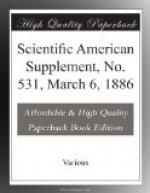In the hope of stimulating thought to this infinite question of proper fuel combustion, with its attendant possibilities for man’s gratification and ambition, this advanced step is presented. The discussion of processes will require an amount of time which I hope this Board will not grudgingly devote to the subject, but which is impossible at present. Do not forget that there is no single spot on the face of the globe where nature has lavished more freely her choicest gifts. Let us be active in the pursuit of the treasure and grateful for the distinguished consideration.
* * * * *
THE ORIGIN OF METEORITES.
On January 9, Professor Dewar delivered the sixth and last of his series of lectures at the Royal Institution on “The Story of a Meteorite.” [For the preceding lectures, see SUPPLEMENTS 529 and 580.] He said that cosmic dust is found on Arctic snows and upon the bottom of the ocean; all over the world, in fact, at some time or other, there has been a large deposit of this meteoric dust, containing little round nodules found also in meteorites. In Greenland some time ago numbers of what were supposed to be meteoric stones were found; they contained iron, and this iron, on being analyzed at Copenhagen, was found to be rich in nickel. The Esquimaux once made knives from iron containing nickel; and as any such alloy they must have found and not manufactured, it was supposed to be of meteoric origin. Some young physicists visited the basaltic coast in Greenland from which some of the supposed meteoric stones had been brought, and in the middle of the rock large nodules were found composed of iron and nickel; it, therefore, became evident that the earth might produce masses not unlike such as come to us as meteorites. The lecturer here exhibited a section of the Greenland rock containing the iron, and nickel alloy, mixed with stony crystals, and its resemblance to a section of a meteorite was obvious. It was 21/2 times denser than water, yet the whole earth is 51/2 times denser than water, so that if we could go deep enough, it is not improbable that our own globe might be found to contain something like meteoric iron. He then called attention to the following tables:
Elementary Substances found in Meteorites.
Hydrogen. Chromium. Arsenic. Lithium. Manganese. Vanadium? Sodium. Iron. Phosphorus. Potassium. Nickel. Sulphur. Magnesium. Cobalt. Oxygen. Calcium. Copper. Silicon. Aluminum. Tin. Carbon. Titanium. Antimony. Chlorine.
Density of Meteorites.
Carbonaceous (Orgueil, etc.)
1.9 to 3
Aluminous (Java) 3.0
" 3.2
Peridotes (Chassigny, etc.)
3.5 " —
Ordinary type (Saint Mes) 3.1
" 3.8
Rich in iron (Sierra de Chuco) 6.5
" 7.0
Iron with stone (Krasnoyarsk) 7.1
" 7.8
True irons (Caille) 7.0
" 8.0




